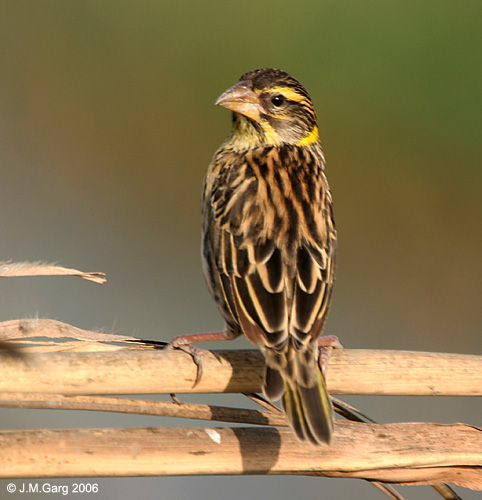- Black-throated Weaver
Taxobox
name = Black-throated Weaver

image_caption = AtHodal inFaridabad District ofHaryana ,India .
status = LC | status_system = IUCN3.1
status_ref = [IUCN2006|assessors=BirdLife International|year=2004|id=53215|title=Ploceus benghalensis|downloaded=2007-04-21 Evaluations in 1988 / 1994 / 2000 / 2004, all LC. Species is described as 'common' in at least parts of its range (Grimmett et al. 1998)] cite book
last = Grimmett
first = Richard
coauthors = Carol Inskipp, and Tim Inskipp
collaborators = Sarath Kotagama and Shahid Ali
illustrators = Clive Byers, Daniel Cole, John Cox, Gerald Driessens, CarlD'Silva, Martin Elliott, Kim Franklin, Alan Harris, Peter Hayman, CraigRobson, Jan Wilczur, and Tim Worfolk
title = Guide to the Birds of Indian subcontinent
year = 1998
publisher= Christopher Helm
address = London
isbn= 0-691-04910-6 ]
regnum =Animal ia
phylum = Chordata
classis = Aves
ordo =Passeriformes
familia =Ploceidae
genus = "Ploceus "
species = "P. benghalensis"
binomial = "Ploceus benghalensis"
binomial_authority = (Linnaeus,1758 )The Black-throated Weaver, also known as the Bengal Weaver or Black-breasted Weaver ("Ploceus benghalensis"), is a weaver resident in the northern river plains of the
Indian subcontinent . Like the other weavers, the males build an enclosed nest from reeds and mud, and visiting females select a mate at least partially based on the quality of the nest.Distribution
Resident or local migrant, endemic to
South Asia .From
NWFP toIndus Valley inPakistan to theGangetic Plains of northernIndia , toAssam and the Northeast andBangladesh ; commonly seen in the Himalayanterai ; patchy to the south inGujarat andAndhra Pradesh .Local Names: _hi. Sarbo baya, _bn. Shor baJa, Kantawala baya.
Description
* Size: Sparrow (ca. 15cm)
* Appearance: Male in breeding plumage has brilliant golden-yellow crown, white throat and a black band separating it from the fulvous-white underparts. In non-breeding male and female, crown brown like rest of upper plumage; black pectoral band less developed. A prominent supercilium, a spot behind ear, and narrow moustachial streaks, pale yellow. Flocks about cultivation and around reedy margins of tanks and jheels (shallow lakes), or extensive tall grass areas.cite book
last = Ali
first = Salim
authorlink=Salim Ali (ornithologist)
coauthors = J C Daniel
title = The book of Indian Birds, Twelfth Centenary edition
year = 1983
publisher=Bombay Natural History Society /Oxford University Press
address = New Delhi]* Behaviour: Polygynous; colonial; on the whole similar to those of the Baya and
Streaked Weaver s.* Courtship: Male constructs the nest single-handedly, with a group of females visiting it during late construction stage, jumping on the "helmets" and tugging and testing, presumably for strength. If a female appears interested, the male bows low before her, presenting golden crown at her. Flaps wings deliberately and sings softly tsi-tsisik-tsisik-tsik-tsik like chirp of cricket or subdued squeaking of unoiled bicycle wheel. Once female agrees and permits copulation, he quickly finishes the rest of the nest, and she lays eggs inside; he immediately commences on a second nest nearby to attract other females, and occasionally a third, very rarely even a fourth. Nests not accepted by females may be torn down by the builder himselfcite book
last = Ali
first = Salim
authorlink=Salim Ali (ornithologist)
coauthors =Sidney Dillon Ripley
title = Handbook of the Birds of India and Pakistan, 2nd ed.,10 vols
year = 1986/2001
edition = 2nd
publisher=Oxford University Press
address = New DelhiSynopsis / Handbook Number 1012, vol. 10, p. 100-102. For Black-throated Weaver beahaviour and nest, quotes articles by Cooke (JBNHS v.60:1-48) and Ambedkar (JBNHS:69:268-82). ] .Nesting
* Season: June to September
* Nest: Similar to the
Streaked Weaver ; somewhat smaller and normally with shorter entrance tubes. Built in reed-beds in marsh, often "moonj" or "kans" ("Saccharum spontaneum "), with some of the growing reeds incorporated into the dome as support. Entrance tube is somewhat shorter thanBaya weavers (up to about 25cm). At the 'helmet' stage of construction a quantity of wet mud orcowdung is daubed thickly along the edge, with bright coloured scarlet or orange flowers or flower petals ("Lantana ,Lagerstroemia ") incorporated; observations suggest that this is part of the courtship rituals and exercise a direct influence on the reactions of the visiting female, both for this species and the Streaked Weaver.* Colony: Singly or in scattered groups of 4 or 5; sometimes larger colonies.
* Eggs: 3 or 4, white, indistinguishable from those of the other two weavers.
References
Wikimedia Foundation. 2010.
